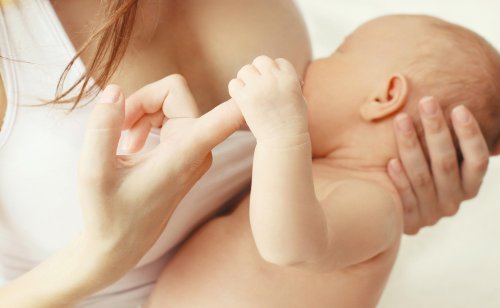Mastitis: Causes, Symptoms and Treatment

In the middle of breastfeeding, we may suddenly feel a lump in one of the milk ducts. Soon after we start to feel a bit ill, something similar to the flu. If this happens to you then you could be suffering from mastitis.
The truth is that this condition is very common in women. It’s believed that one woman in 20 can suffer from this condition during breastfeeding. But what exactly is it?
Read on to find out what mastitis actually is.
What is mastitis?
Mastitis is a breast infection that commonly affects women during lactation.
As mentioned above, this infection occurs because one of the milk ducts becomes blocked, preventing the normal flow of fluid. This, in turn, triggers a series of ailments that show it’s an infection we’re suffering from.
To put it simply, when the liquid doesn’t flow through the breast correctly during lactation, or if the breast isn’t emptied, then mastitis occurs.
The microorganisms accumulate in the milk ducts and infect it; this directly affects the tissue of the mammary duct, thus causing the inflammation that we can see at a glance.
Most common causes
Apart from the obstruction of the duct (milk stasis), another cause of mastitis are cracks in the nipple. These small wounds, which are often inevitable when breastfeeding the baby, are the ideal place for bacteria to invade the breast tissue.
What happens is that these bacteria lodge in the nipples in the small cracks in the skin and make the infection worse. To avoid this, mothers must learn to avoid injuries and empty their breast milk correctly.
All this information may lead us to ask the following question: Can women who don’t breastfeed suffer from this uncomfortable infection? The answer is YES.

What happens when mothers don’t breastfeed?
Mothers who don’t breastfeed their babies have greater complications with their breasts, because of the excess milk that accumulates. When the accumulation of milk is a lasting issue, it can easily generate infection.
Therefore, it’s very important for women who are lactating to empty their breasts correctly and continuously, thus avoiding an unnecessary accumulation. This applies to both those who breastfeed their children directly and those who don’t.
As already mentioned, even mothers who do regularly breastfeed their children should have control over the flow of milk. In addition, women who are low on defenses are much more likely to suffer from this condition.
Common symptoms of mastitis
1. Inflammation: An irritating and noticeable swelling in one of the two breasts.
2. General malaise: A sensation of fatigue, low spirits and/or fever. The intensity of these symptoms will depend on their body’s condition and the evolution of the infection.
In the most severe cases of mastitis, the woman may experience chills, tremors and increased fatigue.
As we can see, these are the common symptoms of any mild infectious process at work in our bodies. Faced with a strong immune system, the infection will only last a few days, but if it’s not treated, it could last for weeks.

Treatment
The treatment for mastitis is very simple when the condition is mild to moderate.
- Place compresses with hot water on the breast. This can significantly reduce the breast pain due to the inflammation. This can be done during the first hours and days of the infection.
- If, after a few days, the discomfort increases, it’s advisable to go to the doctor so that he can prescribe antibiotics and analgesics. Self-medication is not an option when we breastfeed.
Should we breastfeed when we have mastitis?
The answer is yes. In fact, something that can help us eliminate mastitis is the emptying of the breasts. By ensuring that the flow of baby’s milk has an outlet, then there will be no obstruction of the ducts and no complications.
If the bite and sucking of the baby is painful, then we can use devices that help us to express the breast milk. These are small pumps that are placed directly onto the breast, and which extract the milk into a bottle or container.
Once the breast is completely emptied, we can use the bottle to feed the baby without any real discomfort.
Mastitis affects the mother, not the baby. For this reason, we shouldn’t worry about the possibility that the baby will “catch” mastitis.
Other interesting facts
- Mastitis is much more frequent in women under 30 years of age, with early pregnancies.
- It also occurs in women who give birth at between 50 and 60 years of age. These are considered to be unusual cases.
- According to experts, this infection also occurs more easily during the first 12 weeks of breastfeeding. This type is known as postpartum mastitis.
Be careful when the infection evolves untreated, and medium to large abscesses form. If this is the case, we must go to the doctor. He’ll tell you what tests should be done in order to rule out breast cancer or a tumor.
Fortunately, mastitis has a cure. With careful monitoring and follow-up, everything will soon return to normal.
This text is provided for informational purposes only and does not replace consultation with a professional. If in doubt, consult your specialist.








